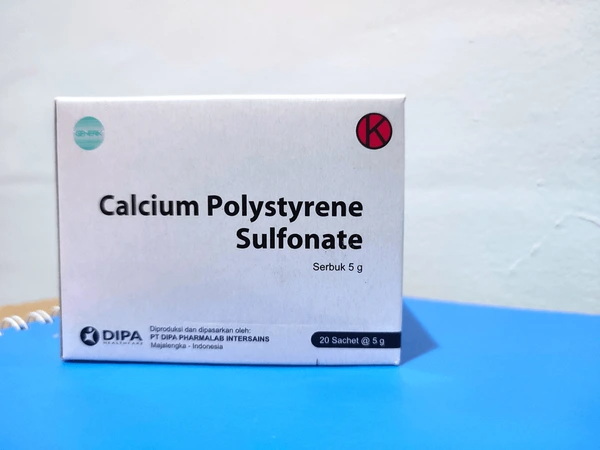
Chemical Structure and Fundamental Properties
Sodium polystyrene sulfonate (SPS) is a sulfonated styrene-divinylbenzene copolymer with the chemical formula (C8H7SO3Na)n. Its cation-exchange capacity (typically 3.1–3.5 mEq/g) stems from sulfonic acid groups (-SO3⁻) attached to the aromatic rings. The material exhibits pH-dependent swelling behavior, expanding up to 200% in aqueous environments due to electrostatic repulsion between charged groups. Particle size distribution (ranging 50–150 μm in pharmaceutical grades) critically influences its water retention capacity (15–25 mL/g) and ion-exchange kinetics. Smaller particles (<75 μm) demonstrate 30% faster potassium-binding rates compared to larger counterparts (>125 μm), as validated by in vitro models.

Synthesis and Purification Methodologies
Industrial production employs suspension polymerization of styrene-divinylbenzene followed by sulfonation with concentrated H2SO4 (98%, 110°C, 6h). Post-synthetic purification involves:
- Solvent extraction (toluene/ethanol 3:1 v/v) to remove residual styrene (<50 ppm, EP limit)
- Bleaching with H2O2/NaOH (5% w/v, pH 10.5) to achieve color index <0.1 AU
- Ion-exchange dialysis against 0.1M NaCl to eliminate free sulfonic acid
The Chinese patent CNB200610019977.6 details a three-step purification achieving 99.8% sodium form purity, meeting JP XIV standards. Critical process parameters include ultrasonic agitation (40 kHz, 300W) during solvent extraction and temperature-controlled bleaching (45±2°C).
Medical Applications in Hyperkalemia Management
As a potassium-binding resin, SPS demonstrates dose-dependent efficacy:
- Oral administration of 30g/day reduces serum K⁺ by 1.04 mEq/L vs placebo (p<0.001) over 7 days
- Rectal administration achieves 0.8–1.2 mEq/L reduction within 4h (serum K⁺ 5.5–6.5 mEq/L baseline)
Clinical protocols require monitoring for gastrointestinal complications:
- 0.2% incidence of severe adverse events (ulceration, necrosis)
- 33% mortality rate in cases with colonic necrosis
- Risk mitigation strategies include sorbitol-free formulations and post-dose hydration protocols

Emerging Non-Medical Applications
Recent patents reveal novel applications:
- Heavy metal detoxification: SPS (6g/dL) removes 92% Pb²⁺ and 85% Cd²⁺ from 1 ppm solutions
- Antimicrobial surfaces: SPS-coated catheters show 3-log reduction in E. coli adhesion
- Battery electrolytes: Crosslinked SPS membranes exhibit ionic conductivity of 0.32×10⁻² S/cm
Performance Limitations and Safety Profile
Key constraints include:
- Na⁺ loading: Each gram exchanges 1.5–2.0 mEq Na⁺, risking hypernatremia (serum Na⁺ >145 mEq/L in 8% of patients)
- Drug interactions: Binds to 40% of oral medications (levothyroxine, warfarin) when co-administered
- Thermal stability: Degrades above 280°C (TGA data), limiting high-temperature processing
Recent safety analyses show a 2.91× increased risk of gastrointestinal complications in older adults, highlighting the need for revised dosing guidelines to ensure safer use across age groups.
Recent Technological Innovations
- Cyclic SPS polymers: Atomic force microscopy confirms ring structures with 12–18 nm diameters, enhancing ion selectivity
- Crosslinked derivatives: Solution-polymerized SPS with divinylbenzene (7.81 mol%) shows 15% improved thermal stability (Tg 112°C vs 104°C)
- Analytical advancements: HPLC-UV methods detect carcinogenic impurities (styrene, DVB) at 0.1 ppm levels
Future Research Directions
- Mucoadhesive formulations: Developing SPS-chitosan composites for targeted colonic delivery
- Biocompatible variants: Grafting polyethylene glycol chains to reduce GI toxicity
- AI-driven optimization: Machine learning models predicting ion-exchange efficiency
- Environmental remediation: Scaling SPS-based filters for industrial wastewater treatment (Pb²⁺ removal cost <$0.05/m³)
Conclusion
Sodium polystyrene sulfonate remains a critical yet complex material in both medical and industrial domains. While its potassium-binding efficacy is well-established, modern research prioritizes toxicity mitigation through advanced formulations and application diversification via material engineering. Emerging synthesis techniques and analytical methods (e.g., cyclic polymer characterization, impurity profiling) address historical quality concerns. Future breakthroughs will likely emerge from multidisciplinary approaches combining polymer science, clinical pharmacology, and environmental engineering, positioning SPS as a versatile platform for next-generation ion-management solutions.
To get detailed scientific explanations of Sodium polystyrene sulfonate, try Patsnap Eureka.

